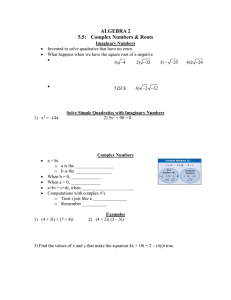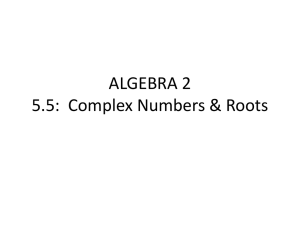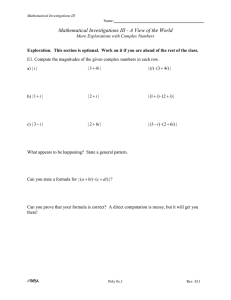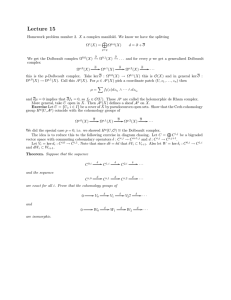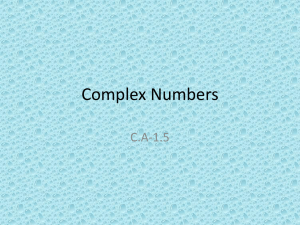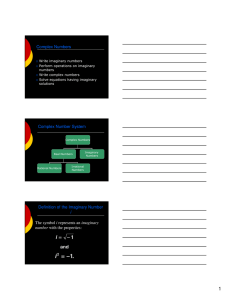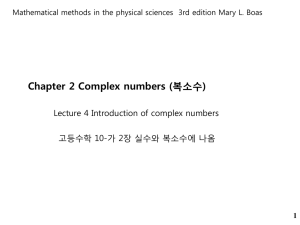z - Dr. Vitaly A. Kudryavtsev
advertisement
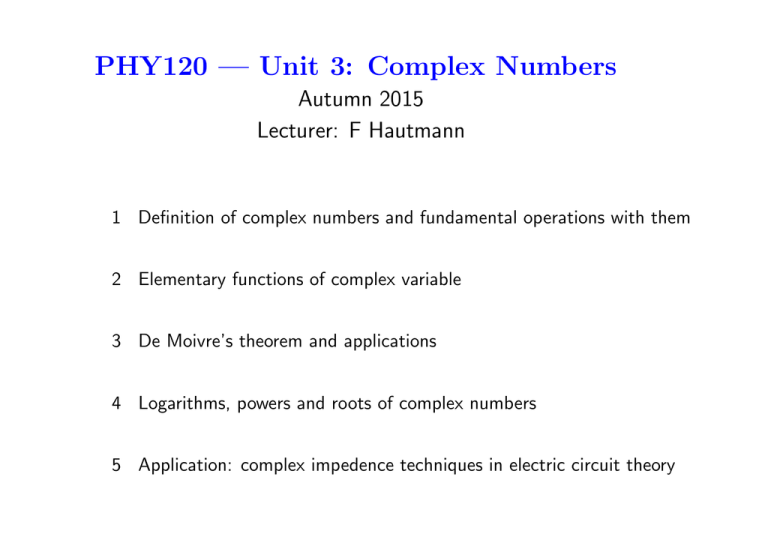
PHY120 — Unit 3: Complex Numbers
Autumn 2015
Lecturer: F Hautmann
1 Definition of complex numbers and fundamental operations with them
2 Elementary functions of complex variable
3 De Moivre’s theorem and applications
4 Logarithms, powers and roots of complex numbers
5 Application: complex impedence techniques in electric circuit theory
!"#$%&'(#)%"*
!"#$%&'()*+$,&-.
!!"#$%"&'($)*+%,'-./,0#01+'0(#+2+%,3'45'65'75'8'8'8
!!"#$%&'"(&)%"#"*+(
!"#$#!%&!'!(!)!*%! ! !(!)!+,!
!!"#$%&"'(
#$%$&'(&)&*& ! &(&)& !" &
!!""#$%&'#()
"#$#%& ! %'%!% ! %&%'% ! %
!!"#$%&'()"*
"#$#%& ! %'%()% ! &%'%*% " ()
!"#"$"%"&'
!"#$%&'()*#+&,"# ! ! !$%
!"#$#%&%&'(%)%&$#%$#&*
!""#"$%&'()"*""#"+,&'(
!"#$%&'$()*&
!+,$-./$(0&'$()*&
!"#$%&'(%)*!+,!'!"-./0!-1)!2-%%)3!4($1)!'5-6'7-184!7$59)1*:0
!"#$%&'&($#"$)
!"#$%
!"#$%&'"()0% ! %*+),-%."1%0/%),%*2",34
!"#$%&
!
!" " " !
# # ! $# !!$%&'()!*+!,-*./$/0,
! ! ! !"# !
!
! ! ! "#$ !
!"#$%
!"#$%&'&($#"$)
5/&678".&*797.-)/"04:;&&
!"#$%
!!"! #
!"#$%&
!
!! !! " !
# " " $" #$%&'()(*$
234&
! ! ! !"# !
!
!"#$%
! ! ! "#$ !
!"#"$!$%&'(! "")"*"(*+! ",
""" " - %&'(! "")"*"(*+! ,"
'()*(&+,"-."/01&
! " !"#$%&'' !"#$%&#'()*#+ ! #$% !" &()$'
<".=,>4/0?&
!""#$#%&'('
!"!#!$!%!&'
"#! $!" % !&!'( # !$!( % )!*!+',# !$!,% )
!
!"#$%&#%'($%)*+
!"!#!$!%!&'
"#" $ !%!&' # !(!)*# +&' $ !(!)*$ +
!
!"#$ %$ & "'"(%(& )"*"+#$ %(& "*"(%$ & )
!"#$%&#%'($%)*+
,)#(-+').)-/%*($01+
!! ! "! "#$%!! " # %&' !! (
" ! #" #$%&! " " $ &'( ! " )
!"
#
"" "# ! #" ## $%&'!" " ! # ( " $ &)*'!" " ! # (
!
! !" !# !!! !# !! !# !
$
!"#!$" $# $ ! !"#!$" $ " !"#!$# $
HISTORICAL NOTE
♦ Imaginary unit i first introduced by algebrists of 16th century:
• Cardano 1540’s: quadratic equation x2 = 10x − 40
• Bombelli 1570’s: cubic equation — really the first calculation manipulating
imaginary numbers; derived rules of addition and multiplication
♦ But not until Euler and Gauss (18th century) was power of complex
numbers really understood — dormant for nearly two centuries
[Gauss, 1799]: any polynomial of degree n has n roots in C.
♦ Geometric interpretation: Argand, 19th century
Complex ↔ ordered pair of real numbers: Hamilton, 19th century
♦ Theory of complex functions developed by
Cauchy, Riemann and others — mid 19th century
!"
!"#"$"%&'
$
!#
!"#"$"%"&'
!"#$"%"&"'(
!()"&('*+%,-.(/'+%&01234(5'
!"#$%$& ' ()((*+*' ( ! (++,(-(./ ' (0(1' 2(3&(45/%(./6#(7(82
"
#$
!
!
%
" "$
#$ " %
$
!
!
!"
!"
!#
"
!
"
#
"
!" !#!
!"
"
!"#"$"%&'
(%)*+',%-%+."&*/0$'
!! ! "! "#$%!! " # %&' !! (
" ! #" #$%&! " " $ &'( ! " )
!"
!!
!"
!
"!
""
##$%&!
!
" ! " ' " # %()&!! " ! " '
$
!!
"!
! !!
!"
""
!"#"$%&'($)*!$+,(-.-/$$
0*!'$$
!
$
!"#$%&'()#'*+,-$$
!
!" ! " " #!
"# ! " ! $!
!!
!! !
!" #
!
!# ! #
#
!" ! !" !
!" $
"
"
""
" # ## " "" "# "
! !!"
"!
"#
" ! $# " "# "#
."/)01()#'*+,-$$
!
! # #!$!" # %!$ " " !" ! '$ # !!# # %$ "
" !"
!
"# &
"(
"
!" ! !"
!
#
"
"
#$
!
!
An application of complex algebra to plane geometry
p
0
2a
q
2d
2b
s
2c
Arbitrary quadrilateral.
Construct squares on each side.
Then
segments joining the centres of
opposite squares are perpendicular
and of equal length.
r
2a+2b+2c+2d=0
i!/2
Center p: a+a e
= a(1+i) ; likewise q=2a+b(1+i)
Thus A
r=2a+2b+c(1+i); s=2a+2b+2c+d(1+i)
s!q = b(1!i)+2c+d(1+i); B r!p = a(1!i)+2b+c(1+i) .
i !/2
A and B perpendicular and of equal length means B=A e
,
i.e. B=iA, i.e. A+ i B=0. Verify that indeed A+iB=0.
PHY120 — Unit 3: Complex Numbers
Lecture 2
• Elementary functions of complex variable
Complex Numbers — Recap
x2 = −1 ⇒ x = i → complex numbers C
♠ Motivation:
i2 = −1 ,
z = a + ib ,
a = Rez ,
a, b real
b = Imz
♠ Argand diagram representation
Im z
z
b
! = mod(z )= | z |
"=arg(z)
!
"
a
b
Re z
z
z = a + ib = ρ(cos θ + i sin θ) = ρeiθ
z = a − ib = ρ(cos θ − i sin θ) = ρe−iθ
♠
C = set of complex numbers with +, × operations
Elementary functions of complex variable
• Polynomials. Rational functions.
•
Exponential
=⇒ Trigonometric fctns. Hyperbolic fctns.
FUNCTIONS OF COMPLEX z = x + iy
f : C→C
f : z &→ w = f (z)
POLYNOMIALS
• defined via algebraic rule for complex multiplication
e.g: f (z) = z 2 = (x + iy)(x + iy) = x2 − y 2 + 2ixy
RATIONAL FUNCTIONS = quotients of polynomials
• also defined via algebraic operations on C:
1 + z∗
1+x
y
1
=
=
−
i
e.g. f (z) =
1+z
|1 + z|2
(1 + x)2 + y 2
(1 + x)2 + y 2
EXPONENTIAL
• defined by power series expansion
• we will define other functions (trig., etc.) in terms of exponential
!"#$%&'#()',)$'3/4+5)#"3-+1()
!
67+)$'3/4+5)+5/'#+#%&84!
'
)
"#$!%!&!'( %)* !
!
(
! "#"$%! "%"
!"#$%&'(!%')$!!!! * &"
!&
&'
%+
+*
!"#$%$&$%$' %() !
!
9+,&#+)%7+)$'3/4+5)+5/'#+#%&84)
!
%"(((%"
!)
)'
'
%"(((
!! ! " " #$
! "#$! %& $&'!
,
-
! ,,, ! -!'. "
%*
*)
"#! ! "#$ !%& " !'& " ((()*+ "! !$ !,& " !-& " ((()
!
%
*
! " #$#%&"#&# "'( &#)))&# "*( &#)))
!"#$%&'#()*+,&#+*)-.)/'0+1)(+1&+()2)
% )/
-)/.*
! +++ ! ,!-. "
0!,,,
% /#0,/#0-.)
! +++
#!
" ! "#$
!
!%
%&
"
!'
'&
! ((()*+ "" !$
",
,&
"
"-&
! ((()
! "#$! %& $&'!
!"#$%&'%(%
! !" ! " !"#$! # "$%& ! ' !" ! " ("! " #$%!
! ! !" ! " !"#$" # "$%& " ' !" ! " ( #"" $ #( #""
! ! ! " !"" " !""
! !!
#
"!"
#
! !!
#!
" ! "#$
!
!%
%&
"
!'
'&
" ((()*+ "! !$
!,
,&
"
!-&
" ((()
! "#$! %& $&'!
/.01+%*+2+
! !" ! " !"#$! # "$%& ! ' !" ! " ("! " #$%!
!"#$%&#%'($%)*+
!! !" ! "!#$!! "" #$!" ! "! "" #$!! #$!" ! "! "" #$#!! "!" $ ! "! "" # %&'#!! " ! " $ " $ '()#!! " ! " $$
,%-%.%)*+
"!#$!!
"! #$!!
"! $!! "$!"
"! $#!! "!" $ "!
!!
! $!" !
!
#
#
#
!
!
$! "
"" #
""
""
""
!" "" #
# %&'#!! " ! " $ " $ '()#!! " ! " $$
EULER’S FORMULAS
"#! ! "#$ !%& " !'& " ((()*+ "! !$ !,& " !-& " ((()
!
%
'
,
-
! "#$! %& $&'!
!"#$%#&'()$)*'$('+")%,#$-$
$ !!
&' " ' "!! (
%
$
#)* ! ! &' !! " ' "!! (
%"
!"# ! !
COMPLEX EXPONENTIAL AND TRIGONOMETRIC FUNCTIONS
0,+(/)#1$+2(+21)*+*3"%$(45*/3")*(
!"#"$%&'(%)"'''! ! ! ! " " #$*
!! "#"$%! "%" !&' %"(((%" !)' %"((("
"*$'$"%&
#% #&
#(
" ! #$ !
#
# !' # "## !
# !'
%" &"
("
! ! )*+ # # " +,- #
"#
!"#"$%&$'()*+(,%-((
$ "!
&' " ' !"! (
%
$
#)* ! ! &' "! ! ' !"! (
%#
!"# ! !
.+*/+(
& !"
$( " ( " % ! !"#) "
'
&
#*+$!"% ! $( ! " ! ( " % ! ! #*+) "
'#
!"#$!"% !
&
)
COMPLEX HYPERBOLIC FUNCTIONS
• For complex z
"
1 ! z
−z
cosh z =
e +e
2
"
1 ! z
−z
sinh z =
e −e
2
hyperbolic functions
! Verify that
cos2 z + sin2 z = 1
cosh2 z − sinh2 z = 1
AN APPLICATION OF COMPLEX EXPONENTIALS:
!"#$%&'(&'$")&)*+,%(,)-(*.+/(+-&)*+*+&0(
!"#$! ! "% ! # #&'$! ! "% " ( #$ ! ! "% " ( #! ( #"
"$!"# !!##&' !%$!"#"!##&'"%
" $!"# ! !"# " ! #&' ! #&' "% ! #$!"# ! #&' " ! #&' ! !"# "%
123,*+)/(.&,%(,)-(+#,/+),.4($,.*0((
!"#$ ! ! "% " !"# ! !"# " ! #&' ! #&' "
#&'$ ! ! "% " #&' ! !"# " ! !"# ! #&' "
• NOTE: complex trigonometric functions can be expressed in
terms of real trigonometric and hyperbolic functions
+&,$-./$0!)/$$ !
! " " #$
$ "!
&' " ' !"! (
%
$
#)* ! ! &' "! ! ' !"! (
%#
!"# ! !
"#$ " ! "#$%# " $%&
' %$# ! %&
%)
" ) % !$# " %& &
(
'
! %) ! % %"#$ # " $$*+#& " ) % %"#$ # ! $ $*+ #&&
(
!
12/2$
!
!"# ! ! !"# " !"#$ # ! $ #%& " #%&$ #!
!"#$!"!%&'&()%*$
$
!"# ! ! !"# " $%!& # " $ $%! " !"#& ##
• Exercise: Determine Re and Im of cos i, sin i.
SOLUTION OF EQUATIONS BY COMPLEX FUNCTION METHODS
• Solve the equation
ez = −1
z
x+iy x
e =e
=e (cos y + i sin y)=
i # (1+2n)
= !1 = e
!i#
n integer
Further examples
• Solve the equation ez = −2.
• Solve the equations
sin z = 2 ,
3 i#
i#
x=0
y=(2n+1) #
Thus z=i # (2n+1) ,
Im z
cosh z = 0 .
Re z
PHY120 — Unit 3: Complex Numbers
Lecture 3
• De Moivre’s theorem and applications
Overview of elementary functions on C
• Complex polynomials and rational functions
defined by algebraic operations +, × in C
• Complex exponential: ez = ex+iy = ex (cos y + i sin y)
• Complex trigonometric and hyperbolic functions:
cos z = (eiz + e−iz )/2 , sin z = (eiz − e−iz )/(2i)
cosh z = (ez + e−z )/2 , sinh z = (ez − e−z )/2
From Euler’s formulas to De Moivre’s theorem
eiθ = cos θ + i sin θ
e−iθ = cos θ − i sin θ
• Can invert these relations:
Euler’s formulas
"
1 ! iθ
−iθ
e +e
cos θ =
2
"
1 ! iθ
−iθ
sin θ =
e −e
2i
• Taking n powers of the exponential (eiθ )n in the formula at the top yields
(cos θ + i sin θ)n = cos nθ + i sin nθ
De Moivre" s theorem
!"#$%&'(")*#+,"%("-#./!#+(&0%/%-"+(&1#&!"/+&+&"*##
$! "
" %"!
! ! !#" # ! # "
"
! # !$%& "! " %&'( "! #
"
2%(#(34#
"! #
#
$
!
"%&'
!
"
"'()
!
$
!
%&'
#
!
"
"'()
#
!
#
"#
!
5"#$%&'("#
"606#/37#8#
"#$ !! ! "#$ ! ! " $%& ! !
$%& !! ! ! "#$ ! $%& !
• EXERCISE: Prove the trigonometric identity
sin3 θ = [3 sin θ − sin 3θ]/4
#! iθ
"
$3
−iθ
sin θ = e − e
/(2i)
# 3iθ
$
2iθ −iθ
iθ −2iθ
−3iθ
= −(1/(8i)) e − 3e e
+ 3e e
−e
#! 3iθ
"
! iθ
"$
−3iθ
−iθ
=− e −e
−3 e −e
/(8i)
3
= −[sin 3θ − 3 sin θ]/4
• Similarly to higher powers, e.g.:
cos4 θ = [cos 4θ + 4 cos 2θ + 3]/8
!"#"$%&$'#$(%)*+#$,-'$.%/01#2$#20%-#-3),1"$$
%
"#
!
"$
!
425$6$$$$7)-'$$
8,9)-:$0%;#+"$)"$/<.=$")/01#+$)-$0%1,+$&%+/$"%$;#$;+)3#$$
5$
"# ! "$ " "%$ &"! #'
!
>#-.#$$
5$
5$$
!" ! !#$ " ! !%# &!! #' #$ " "(& %! ! " "(
!"#"$%&$'#$(%)*+#$,-'$.%/01#2$#20%-#-3),1"$$
425$6$$$$$$7%1*)-8$')&&#+#-3),1$#9:,3)%-"$
!,"
!"#$%&'()*&+$)&$ ! , ! " " -$*%$%*./'0$1*2#+$30
!
!" ! #"
$!
!"#$#%! ! " " #$%&'%(%)*+,-#.%)*/'0(/01
! ! " " #!
! ! "#$!% ! "#$$ " " #$%$&'(! " #()* ! %%
! "()* ! " $&'(!
!"#"$
!! "
!!
!
! " " "#$ ! ! ! #% " &' ! ! ! "#$ ! " " $%& !
!!#
!
!"#"$%&$'#$(%)*+#$,-'$.%/01#2$#20%-#-3),1"$$
425$6$$$78//)-9$"#+)#"$
"
$"
#595$7:%;$$
!
&'(#!! " $%! !
! !"
!
""
!!!
!
#$ " " % &'( !
)
$ # !" *+& !! " " !
! ! ! !"
"#$%&! " '(# ! )* " " ! %+#%&!"'(# ( ! )*%+## " %"+ &## ( ! (
!
! !"#$!!
!
%
'
&!!
% " "$
$!! #% " "$ "&!! '
! !"#
'
&!!
"&!!
#% " "$ '#% " "$ '
!
()* ! " " ()* !
% " &" +,( &! " " &
Exercises
♦ 1. Find Re and Im of 1/(1 − z), where z = reiθ , and hence
%∞ n
sum the series n=0 r cos(nθ) for r < 1.
r sin θ
1 − z∗
1
1 − r cos θ
Answ. :
+
i
=
=
1−z
|1 − z|2
1 + r2 − 2r cos θ
1 + r2 − 2r cos θ
!
"#
$
!
"#
$
Re
∞
%
rn cos(nθ) =
n=0
∞
%
Im
rn Re einθ = Re
n=0
♦ 2. Show that 1 +
∞
%
(reiθ )n
n=0
= Re
1
1 − r cos θ
=
1 − reiθ
1 + r2 − 2r cos θ
cos θ
2
+
cos 2θ
4
+
cos 3θ
8
+ ... =
4−2 cos θ
5−4 cos θ
.
∞
∞ & iθ 'n
∞
%
%
%
1
e
cos(nθ)
inθ
=
Re
e
=
Re
Answ. :
2n
2n
2
n=0
n=0
n=0
= Re
1
1 − cos θ/2
4 − 2 cos θ
=
=
1 − eiθ /2
1 + 1/4 − cos θ
5 − 4 cos θ
Exercise
Prove the identity
N
−1
&
sin(N x/2)
cos(nx) =
cos((N − 1)x/2) .
sin(x/2)
n=0
N
−1
&
cos(nx) = Re
n=0
N
−1
&
einx = Re (
n=0
= Re
+
!
∞
&
einx −
n=0
iN x
1−e
"
∞
&
n=0
inx
e
,
∞
&
einx
)
n=N
' !() *
inx
eiN x ∞
n=0 e
1 − eiN x
= Re
1 − eix
sin(N x/2)
eiN x/2 [−2i sin(N x/2)]
i(N −1)x/2
=
= Re
Re
e
sin(x/2)
eix/2 [−2i sin(x/2)]
sin(N x/2)
cos((N − 1)x/2)
=
sin(x/2)
CURVES IN THE COMPLEX PLANE
• locus of points satisfying constraint in complex variable z
Examples
Im z
1
|z| = 1
Re z
Im z
z − z* = i
i/2
Re z
Im z
arg z = ! / 3
Re z
!"#$%&'()'*+%',-./0%1'/02)%'
81'7'
! ! !" !
" ! #$
-#' !!"!#
!!
$
" # ! !" #$%&!
! ""#$ " %&
!(#,0%',%)*#%'9454:5'#26("&'7'
! ! ! !! !" "
!(#,0%',%)*#%'345'#26("&'7'
##$! ! !" % ! ! $" ! "" % ! " &
# " ! ! $"
!"#$%&'()'*+%',-./0%1'/02)%'
31'4'
!
! !"
! ""
!# !
! " ! ! " "!" ! " " "
5(&*2),%'6#-.'789:;'<'=(&*2),%'6#-.'789>:;'
'(""#$% ! ! #! ! &% ! " #$% ! ! #! ! &% !
! ! !" " #$%&'(%$%)
?%20'21(&'
! ! " " #$
PHY120 — Unit 3: Complex Numbers
Lecture 4
• The logarithm function
• Complex powers
• Roots of complex numbers
!"#$%&'()#*$)&+,-./"'$
!" !
#!" ! ! ! !!" " " #$! ! ! "#" !"!"! ! ! "#" !"#"!
!
!" ! ! !" " ! " #" #$%&!'
!""#$%&$'(&)$! $*(+,-#*(.$/" ($0123"$245*.-*%6$*($7
ln z = ln |z| + i(θ + 2πn) ,
n integer
• different n ⇒ different “branches” of the logarithm
• n = 0: “principal” branch
• ln z is our first example of “multi-valued” functions
Remark
♦ eln z always equals z, while ln ez does not always equal z.
Verify:
z = a + ib = reiθ
Then ln z = ln r + i(θ + 2πn) , n integer.
iθ
So eln z = eln r+i(θ+2πn) = reiθ e!2πni
=
re
= z.
"# $
1
On the other hand ez = ea+ib = ea eib
So ln ez = ln ea + i(b + 2πn) = a + ib +2πin = z + 2πin which may be #= z.
! "# $
z
HISTORICAL NOTE
♦ 1712: exchange of letters between Bernoulli and Leibniz
on the meaning of ln(−1). Neither one got it right.
[Bernoulli: It is 0; Leibniz: No, it must be < 0.]
♦ Sorted out by Euler, 1749: ln(−1) = iπ. (for n = 0)
ln(−1) = ln eiπ = ln 1 + i(π + 2πn) = iπ + 2πin , n integer
EXERCISES
Find Re and Im of ln z (n = 0 branch) for
a) z = i
b) z = 1 + i
c) z = 1 − i
COMPLEX POWERS
f (z) = z α , when both z and α are complex,
can now be defined using the complex logarithm:
z α = eα ln z
Because ln z is multi-valued, so is z α .
Example
Show that ii is real and the principal-branch value is
√
i
i = 1/ eπ
[Euler, 1746]
ii = ei ln i = ei[ln 1+i(π/2+2πn)] = e−π/2−2πn
• Exercise: by similar method, find all the values of (1 + i)i .
ROOTS OF COMPLEX NUMBERS
Def.:
• A number u is said to be an n-th root of complex number z
if un = z, and we write u = z 1/n .
Th.:
• Every complex number has exactly n distinct n-th roots.
Let z = r(cos θ + i sin θ); u = ρ(cos α + i sin α). Then
r(cos θ + i sin θ) = ρn (cos α + i sin α)n = ρn (cos nα + i sin nα)
⇒ ρn = r ,
nα = θ + 2πk
Thus ρ = r 1/n ,
(k integer)
α = θ/n + 2πk/n .
n distinct values for k from 0 to n − 1. (z "= 0)
%
So u = z 1/n = r 1/n cos
&
θ
2πk
+
n
n
'
+ i sin
&
θ
2πk
+
n
n
'(
,
k = 0, 1, . . . , n−1
Note. f (z) = z 1/n is a “multi-valued” function.
!"#$%&'()(*(+,-(.//,0(/1(2+3,4(*(
" ! ! ! "##$# " ! ! ! ! $%
! " " !!!!
! ! !""! #
" !!" $ ! !""! # " $
""!
""!
!#$%&
'##%()&
'
$
$
'!!
'!!
! " #$%&
( # "%)*&
( &! " +$!$'$,$-(%
"
"
!!"
Example 2. Find all cubic roots of z = −1 + i:
u = (−1 + i)1/3
%
&
'
&
'(
√ 1/3
3π 1 2πk
3π 1 2πk
u = ( 2)
cos
+
+
+ i sin
,
4 3
3
4 3
3
that is,
)
*
π
π
1/6
k=0: 2
cos 4 + i sin 4
)
*
11π
11π
1/6
k=1
k=1: 2
cos 12 + i sin 12
*
)
19π
19π
1/6
k=2: 2
cos 12 + i sin 12
k = 0, 1, 2
k=0
k=2
• Equivalently:
u = (−1 + i)
1/3
(1/3) ln(−1+i)
(1/3)[ln
=e
=e
√ 1/3 i(π/4+2kπ/3)
= ( 2) e
√
2+i(3π/4+2kπ)]
Example 3:
z 5 + 32 = 0
• The solutions of the given equation are the fifth roots of −32:
(−32)
1/5
1/5
= 32
%
cos
&
π 2πk
+
5
5
'
+ i sin
&
π 2πk
+
5
5
'(
,
that is,
*
)
π
π
k = 0 : 2 cos 5 + i sin 5
*
)
3π
3π
k = 1 : 2 cos 5 + i sin 5
k = 2 : −2
*
)
7π
7π
k = 3 : 2 cos 5 + i sin 5
)
*
9π
9π
k = 4 : 2 cos 5 + i sin 5
k=1
k = 0, 1, 2, 3, 4
Im z
k=0
k=2
Re z
k=4
k=3
!""#$%"&%'"()*"+,-($%
" # # $ " $! # ! ! $! !! # ! !! ! ! ! $" "
#! " ! "! " ! #
! !" !"#!$!%&&'
[Gauss, 1799]
• fundamental theorem of algebra is treated in more advanced courses
!! " ! ! !" " ! !#
!"#"$%&'()'*+$!%&'*,-.$/$
=,,3./$
""$!
!! #
!
$
"
!"! ! %!! !#
"
<$
!!!
8$
52$+,167!89$),,3.$+,1!$:-$+,167!8$+,-;&#'3!$6':).$
0&1$,2$),,3.$
!
!!
! !# "! " "" $
!"
4),(&+3$,2$),,3.$
8$
!!
! ""$"#
!#
2,)$),,3.$
>!-!)'7$.,7&*,-.$-,3$'?':7'@7!$2,)$A:#A!)$,)(!)$6,7B-,1:'7.$C%&')*+.$'-($'@,?!D$
H$
E'-$F-($.,7&*,-.$:-$.6!+:'7$+'.!.G"$
PHY120 — Unit 3: Complex Numbers
Lecture 5
• Application: complex impedence techniques in
electric circuit theory
Currents and voltages in simple circuits of resistors:
OHM! S LAW
V2 = V0
V0
V = IR
R2
R1 + R2
V3 = V4 = V0
(R3 || R4 )
(voltage divider)
R34
,
R1 + R2 + R34
R34 =
R3 R4
R3 + R4
ALTERNATING CURRENT:
I = I0 cos ωt
(I0 = current amplitude , ω = frequency)
• voltage across each element is not necessarily in phase with the
current through that element
• relationship between magnitudes of voltage and current depends on
frequency ω
⇒ V = Z(ω)I
where Z = complex impedence
describes magnitude and phase of voltage-current relationship
ALTERNATING CURRENT: I = I0 cos ωt
Resistor
♦ Voltage across the resistor:
V = IR = I0 R cos ωt
• amplitude V0 = I0 R
• voltage in phase with the current
ALTERNATING CURRENT: I = I0 cos ωt
Inductor
♦ Voltage across the inductor:
dI
V =L
= −I0 ωL sin ωt
dt
= I0 ωL cos(ωt + π/2)
• amplitude V0 = I0 ωL
• voltage out of phase: it leads the current by π/2
ALTERNATING CURRENT: I = I0 cos ωt
Capacitor
♦ Voltage across the capacitor:
!
1
1
I dt = I0
sin ωt
V =
C
ωC
1
= I0
cos(ωt − π/2)
ωC
• amplitude V0 = I0 /(ωC)
• voltage out of phase: it lags the current by π/2
COMPLEX IMPEDENCES
V = Z(ω)I
I = Re(I0 eiωt ) ,
V = Re(V0 eiωt )
ZR = R
resistor
ZL = iωL
inductor
1
ZC =
iωC
capacitor
Example: RC series circuit
Z = R + 1/(iωC)
"
= R2 + (ωC)−2 e−iφ , where tan φ = 1/(ωRC)
• voltage lags the current by φ = arctan(1/(ωRC))
• voltage drop across the resistor:
"
R|V1 /Z| = V1 R/ R2 + (ωC)−2
• voltage V2 on the capacitor:
"
−1
−1
−iφ21
V2 = V1 (iωC) /[R + (iωC) ] = V1 e
/ (ωRC)2 + 1 , tan φ21 = ωRC
Example: RL series circuit
Z = R + iωL
"
= R2 + (ωL)2 eiφ , where
tan φ = ωL/R
• voltage leads the current by φ = arctan(ωL/R))
• voltage drop across the resistor:
"
R|V1 /Z| = V1 R/ R2 + (ωL)2
• voltage V2 across the inductor:
"
iφ21
V2 = iωLV1 /(R + iωL) = V1 e
/ 1 + R2 /(ωL)2 , tan φ21 = R/(ωL)
RC and RL circuits:
|V2 /V1 | and |φ21 | versus frequency ω
